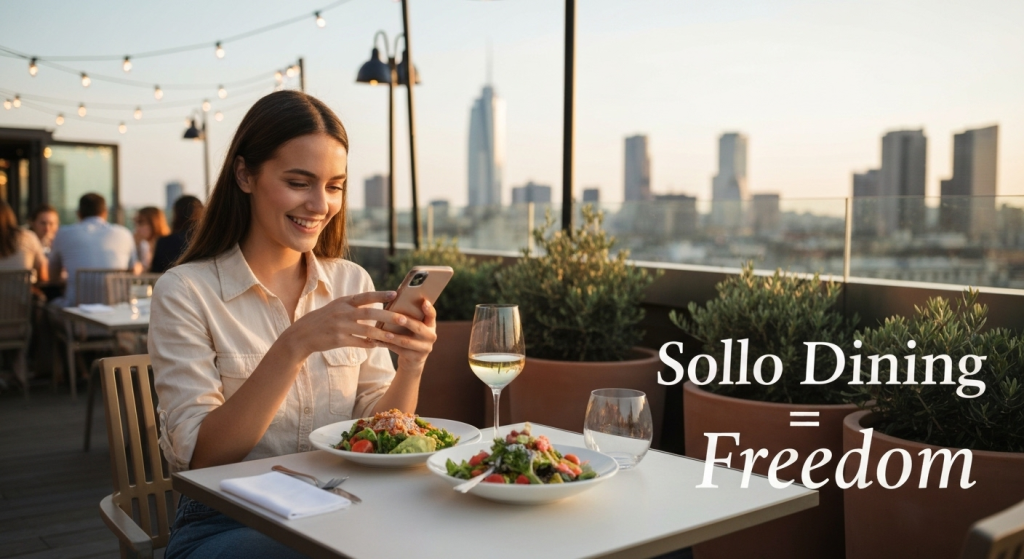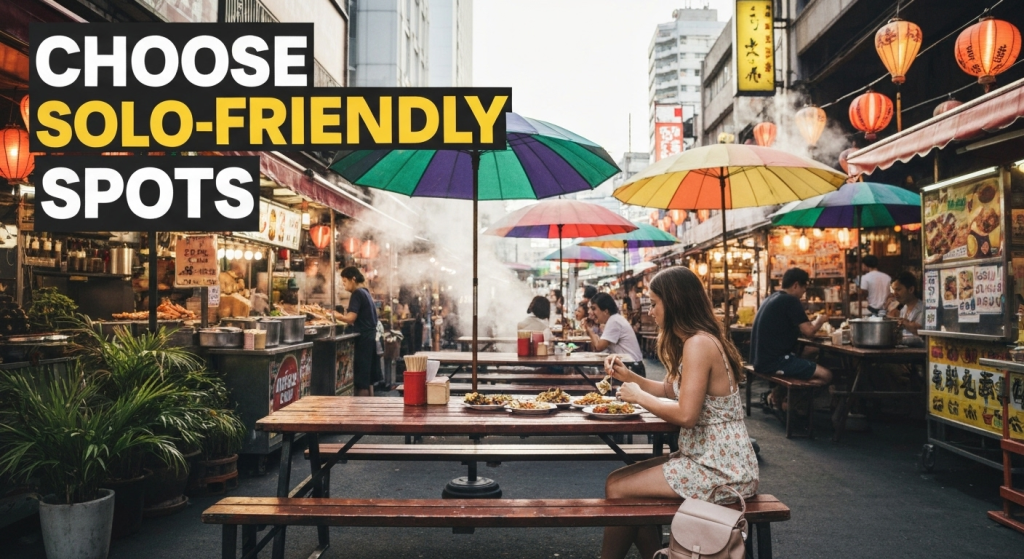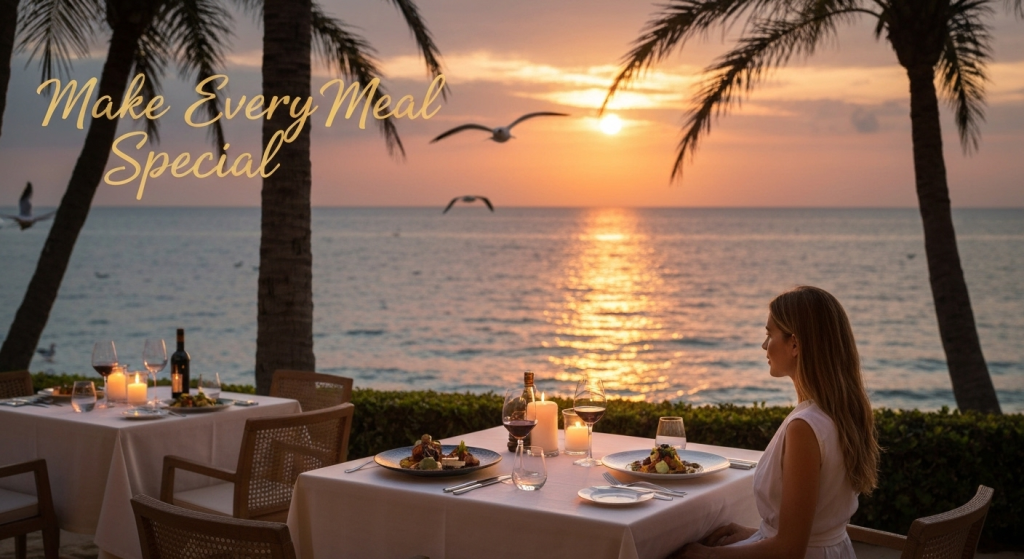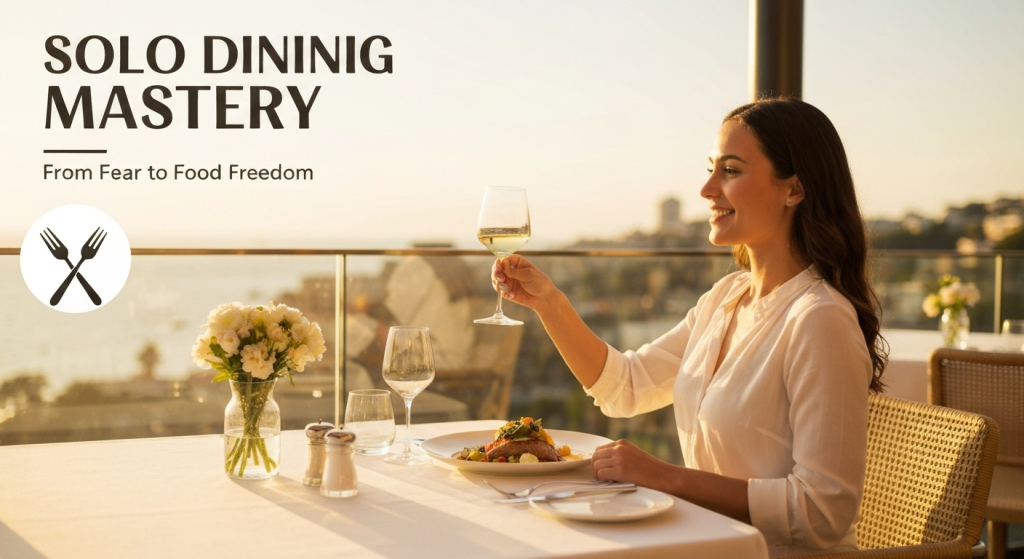Eating alone used to terrify me. The thought of sitting at a restaurant table by myself, surrounded by couples and groups, made my stomach churn with anxiety. But after five years of solo travel and countless meals enjoyed in my own company, I’ve discovered something remarkable: dining alone isn’t just acceptable—it’s actually one of life’s greatest pleasures.
My name is Mahnoor Farooq, and I’m a professional travel consultant with over five years of experience helping people navigate the world of solo adventures. During my journey from anxious solo diner to confident culinary explorer, I’ve learned that eating alone opens doors to experiences you simply can’t have when dining with others. Let me share how I transformed my relationship with solo dining and how you can do the same.
Why Solo Dining Feels So Scary (And Why It Shouldn’t)

Most people avoid eating alone because of deep-rooted social conditioning. We’ve been taught that meals are communal experiences, meant to be shared with family and friends. This belief creates unnecessary shame around solo dining.
The fear stems from several common concerns:
Social Judgment: We worry that others will pity us or assume we’re lonely. In reality, most people are too focused on their own meals to judge yours.
Boredom: Without conversation, many believe meals become dull. This couldn’t be further from the truth—solo dining allows you to truly taste and appreciate your food.
Safety Concerns: Some worry about appearing vulnerable when alone. With proper precautions, solo dining is perfectly safe in most establishments.
Cultural Expectations: Many societies view solo dining as unusual or sad. These outdated perspectives are rapidly changing as more people embrace independence.
During my first solo trip to Bangkok in 2019, I spent three days eating street food standing up because I was too scared to sit alone at a proper restaurant. I missed out on incredible local experiences because of unfounded fears. This experience taught me that the only barrier to enjoying solo meals was my own mindset.
The Hidden Benefits of Eating Alone
Solo dining offers advantages that group dining simply cannot match. After hundreds of solo meals across different countries, I’ve identified key benefits that transformed my entire approach to food and travel.
Enhanced Sensory Experience
When you eat alone, your attention focuses entirely on the food. Without conversation distracting you, every flavor becomes more pronounced. The texture of perfectly cooked pasta, the aroma of fresh herbs, the visual presentation—everything becomes more vivid.
I remember my first solo dinner at a small Italian trattoria in Rome. Without friends to chat with, I noticed how the chef hand-rolled each piece of gnocchi. I tasted the subtle difference between the house-made sauce and typical restaurant marinara. This meal became a sensory education I never would have experienced with dining companions.
Freedom to Choose
Solo dining means eating exactly what you want, when you want it. No compromises on restaurant selection, no waiting for others to decide, no settling for shared dishes you don’t enjoy.
Your Schedule: Eat breakfast at 11 AM or dinner at 5 PM—it’s entirely up to you.
Your Preferences: Crave spicy Thai food while traveling through mild-cuisine countries? Go for it without worrying about others’ comfort levels.
Your Budget: Spend lavishly on that special tasting menu or stick to street food—the choice is yours alone.
Authentic Local Interactions
Restaurant staff often engage more with solo diners. Servers share recommendations, chefs might send complimentary dishes, and you’re more likely to strike up conversations with locals at the bar or neighboring tables.
My Personal Journey: From Fear to Freedom
My transformation began during a work trip to Istanbul in 2020. Exhausted from client meetings, I found myself standing outside a beautiful rooftop restaurant, too intimidated to enter alone. A friendly host noticed my hesitation and invited me to the chef’s counter, where I could watch the kitchen in action.
That single meal changed everything. I learned about Ottoman spice combinations from the chef, tried dishes I’d never heard of, and left with recipe cards and new friends. The experience taught me that solo dining isn’t about being alone—it’s about being open to new connections and experiences.
Building Confidence Gradually
Start small and build your comfort level progressively. Here’s how I developed my solo dining confidence:
Week 1-2: Coffee shops and casual cafes during off-peak hours Week 3-4: Fast-casual restaurants with counter seating Week 5-6: Mid-range restaurants during lunch hours Week 7+: Fine dining establishments and popular dinner spots
Each successful solo meal builds confidence for the next level. Don’t rush the process—everyone develops at their own pace.
Practical Strategies for Successful Solo Dining

Choosing the Right Restaurants
Not all restaurants are equally solo-friendly. Some establishments naturally accommodate single diners better than others.
| Restaurant Type | Solo-Friendly Rating | Best Features |
|---|---|---|
| Sushi Bars | Excellent | Counter seating, chef interaction |
| Tapas Restaurants | Very Good | Small plates, casual atmosphere |
| Hotel Restaurants | Very Good | Professional service, solo business travelers |
| Coffee Shops | Excellent | Relaxed environment, laptop-friendly |
| Food Halls | Excellent | Variety, casual seating, people-watching |
| Fine Dining | Good | Attentive service, special occasion feel |
Timing Your Visit
Strategic timing makes solo dining more comfortable and enjoyable:
Lunch Hours (11:30 AM – 2:00 PM): Business diners create a professional atmosphere where solo eating feels natural.
Early Dinner (5:00 PM – 6:30 PM): Restaurants are less crowded, servers have more time to chat, and you’ll often spot other solo diners.
Happy Hour (4:00 PM – 7:00 PM): Bar seating encourages conversation, and the casual atmosphere reduces pressure.
Seating Strategies
Where you sit significantly impacts your solo dining experience:
Counter/Bar Seating: My personal favorite. You can watch food preparation, easily chat with staff, and feel less conspicuous than at a traditional table.
Corner Tables: Provide privacy and a good view of the restaurant activity.
Window Seats: Perfect for people-watching and enjoying natural light.
Avoid: Large round tables or booths designed for groups—these emphasize your solo status unnecessarily.
Essential Tools for Solo Diners
Digital Companions
Reservation Apps: OpenTable, Resy, and similar platforms often indicate counter seating availability.
Restaurant Reviews: Read recent reviews specifically mentioning solo dining experiences.
Translation Apps: Essential for non-English speaking destinations—Google Translate’s camera feature works wonders with menus.
Physical Essentials
Keep these items handy for comfortable solo dining:
- Portable phone charger: Never worry about your phone dying mid-meal
- Small notebook: Jot down favorite dishes or wine pairings
- Business cards: Exchange contact information with new acquaintances
- Cash tips: Show appreciation for exceptional service from solo-friendly staff
Overcoming Common Challenges
Dealing with Awkward Moments
Every solo diner faces uncomfortable situations. Here’s how I handle common challenges:
The Pity Look: When someone gives you that “poor thing eating alone” expression, simply smile confidently. Your comfort with the situation often changes their perception.
Overly Helpful Staff: Some servers hover excessively around solo diners. Politely indicate when you’d prefer to dine undisturbed: “I’m really enjoying this quiet time to savor the food.”
Long Waits: Solo diners sometimes wait longer for tables. Make reservations when possible, or use the wait time to enjoy a cocktail at the bar.
Managing Technology Etiquette
While phones can provide comfort for nervous solo diners, use them strategically:
DO: Check messages between courses, research your next destination, or scroll social media during natural breaks.
DON’T: Remain glued to your screen throughout the entire meal. You’ll miss opportunities for genuine experiences and connections.
ALTERNATIVE: Bring a book or travel journal. These create natural conversation starters and appear more sophisticated than constant phone use.
Cultural Considerations Around the World

Solo dining acceptance varies dramatically between cultures. Understanding these differences helps you navigate different destinations successfully.
Solo-Friendly Cultures
Japan: Solo dining is completely normal. Many restaurants have specific counter seating for individual diners.
South Korea: Growing acceptance, especially in urban areas. Korean BBQ restaurants now offer single-portion options.
Scandinavia: Independent dining is culturally accepted and common.
United States: Generally accepting, particularly in major cities and business districts.
Challenging Regions
Mediterranean Countries: Traditional family-oriented dining culture can make solo meals feel awkward, especially at dinner.
Middle Eastern Countries: Cultural emphasis on communal eating makes solo dining less common.
Parts of Latin America: Family-style dining traditions might make solo diners feel out of place.
Adaptation Strategy: In challenging regions, focus on lunch meals, casual establishments, or hotel restaurants where business travelers commonly dine alone.
Advanced Solo Dining Techniques
Once you’ve mastered basic solo dining, these advanced strategies will elevate your experience:
The Art of Conversation
Engaging with restaurant staff and fellow diners becomes easier with practice:
With Servers: Ask about ingredients, preparation methods, or local food history. Most culinary professionals love sharing their knowledge.
With Chefs: Compliment specific dishes and ask about their inspiration. Many chefs appreciate direct feedback from engaged diners.
With Other Guests: Comment on shared experiences—the atmosphere, a particularly good dish, or local recommendations.
Building Repeat Relationships
Regular solo diners often become valued restaurant customers:
- Remember Names: Learn your server’s and bartender’s names for personalized service
- Share Feedback: Provide constructive comments about meals and service
- Be Consistent: Regular visits build relationships that enhance future dining experiences
Economic Advantages of Solo Dining
Solo dining often provides better value than group meals:
Cost Benefits
| Advantage | How It Works | Typical Savings |
|---|---|---|
| No Sharing | Order exactly what you want | 15-25% |
| Happy Hour Access | Early dining qualifies for specials | 20-40% |
| Counter Specials | Bar seating often includes deals | 10-20% |
| Portion Control | No pressure to over-order | 20-30% |
| Wine by Glass | No need to commit to full bottles | Variable |
Tipping Considerations
Solo diners should tip generously, especially when receiving excellent service. Staff often go above and beyond for solo guests, and proper appreciation encourages continued solo-friendly service.
Safety Guidelines for Solo Diners
While solo dining is generally safe, smart precautions ensure enjoyable experiences:
Basic Safety Measures
Research Locations: Check restaurant reviews for safety comments and neighborhood information.
Share Your Plans: Tell someone your dining location and expected return time.
Trust Instincts: If a situation feels uncomfortable, don’t hesitate to leave.
Stay Alert: Moderate alcohol consumption to maintain awareness of your surroundings.
Special Considerations for Different Demographics
Women: Choose well-lit, reputable establishments. Avoid secluded restaurants, especially for evening meals.
Older Adults: Select restaurants with easy accessibility and clear lighting.
Young Adults: Stick to busy, well-reviewed establishments in safe neighborhoods.
Creating Memorable Solo Dining Experiences

Transform routine meals into special occasions with intentional planning:
Special Occasion Solo Dining
Birthday Meals: Celebrate with a tasting menu at your dream restaurant.
Achievement Celebrations: Mark professional or personal milestones with memorable meals.
Cultural Exploration: Use solo dining to explore cuisines you’ve never tried.
Documentation and Memory-Making
- Food Photography: Capture beautiful presentations without worrying about others’ patience
- Tasting Notes: Keep a food diary of exceptional meals and discoveries
- Recipe Collection: Ask for preparation tips to recreate favorites at home
Frequently Asked Questions
Q: Is it weird to eat alone at expensive restaurants? A: Not at all. Fine dining establishments regularly serve solo business travelers and food enthusiasts. Many offer special counter seating specifically for individual diners.
Q: How do I handle reservations as a solo diner? A: Be upfront about dining alone when making reservations. Many restaurants can accommodate solo diners more easily than large groups and may offer preferred seating options.
Q: What should I do if I feel anxious during my first solo meal? A: Start with familiar cuisines at casual restaurants during less busy hours. Bring a book or journal for comfort, and remember that most people aren’t paying attention to other diners.
Q: Are there any restaurants I should avoid as a solo diner? A: Extremely romantic establishments, large family-style restaurants, and places known primarily for sharing plates might feel uncomfortable for solo diners. Trust your instincts about the atmosphere.
Conclusion
Solo dining isn’t just about eating alone—it’s about embracing independence, discovering new flavors, and creating meaningful connections with food and culture. My journey from anxious solo diner to confident culinary explorer taught me that the best meals often happen when you’re brave enough to sit at that table for one.
The skills you develop through solo dining extend far beyond restaurants. You’ll build confidence, improve decision-making abilities, and develop a deeper appreciation for life’s simple pleasures. Every meal becomes an opportunity for discovery rather than just sustenance.
Start small, be patient with yourself, and remember that every confident solo diner was once exactly where you are now—standing outside that restaurant, wondering if they’re brave enough to go in alone. Take that first step. Your taste buds, your confidence, and your sense of adventure will thank you for it.



